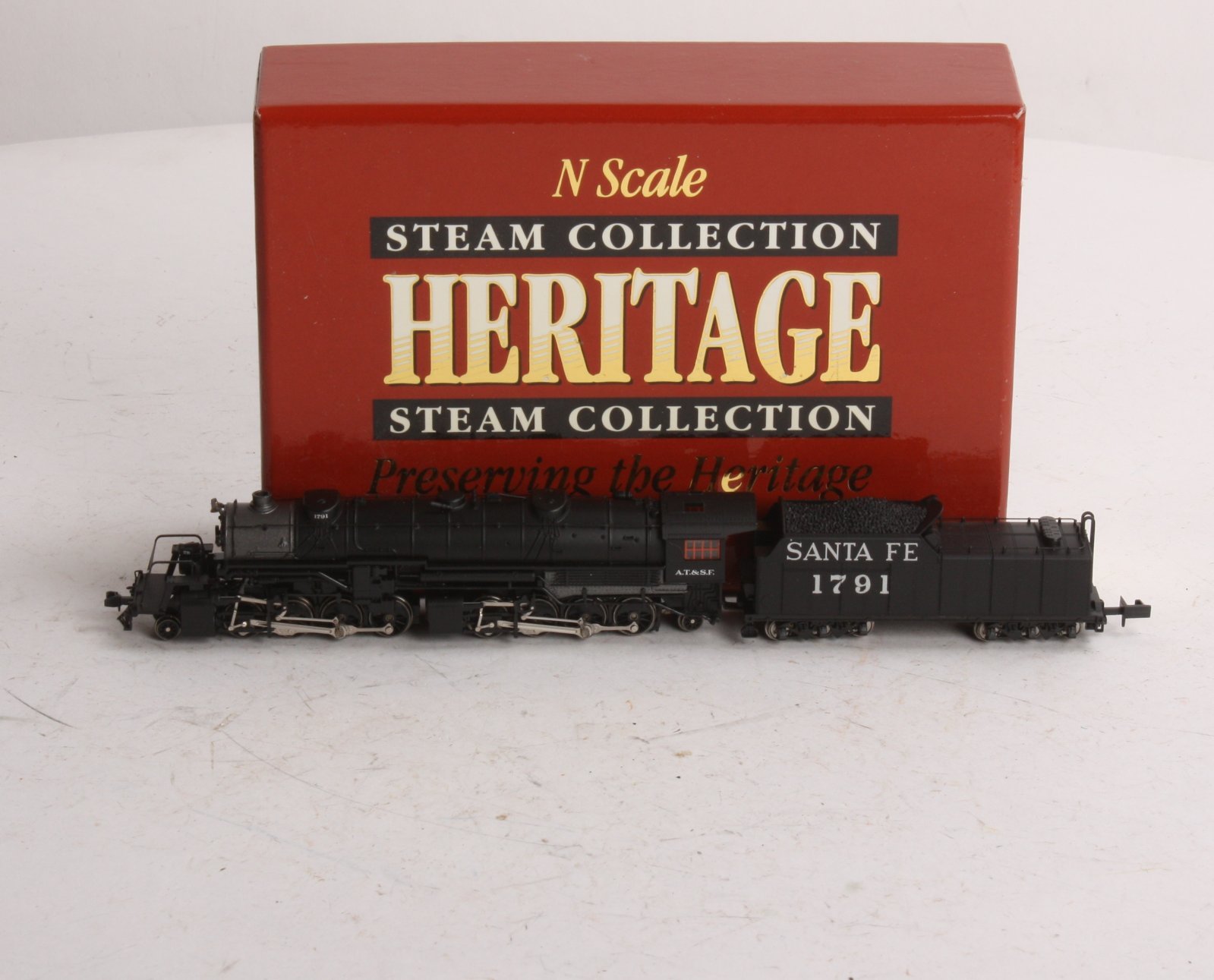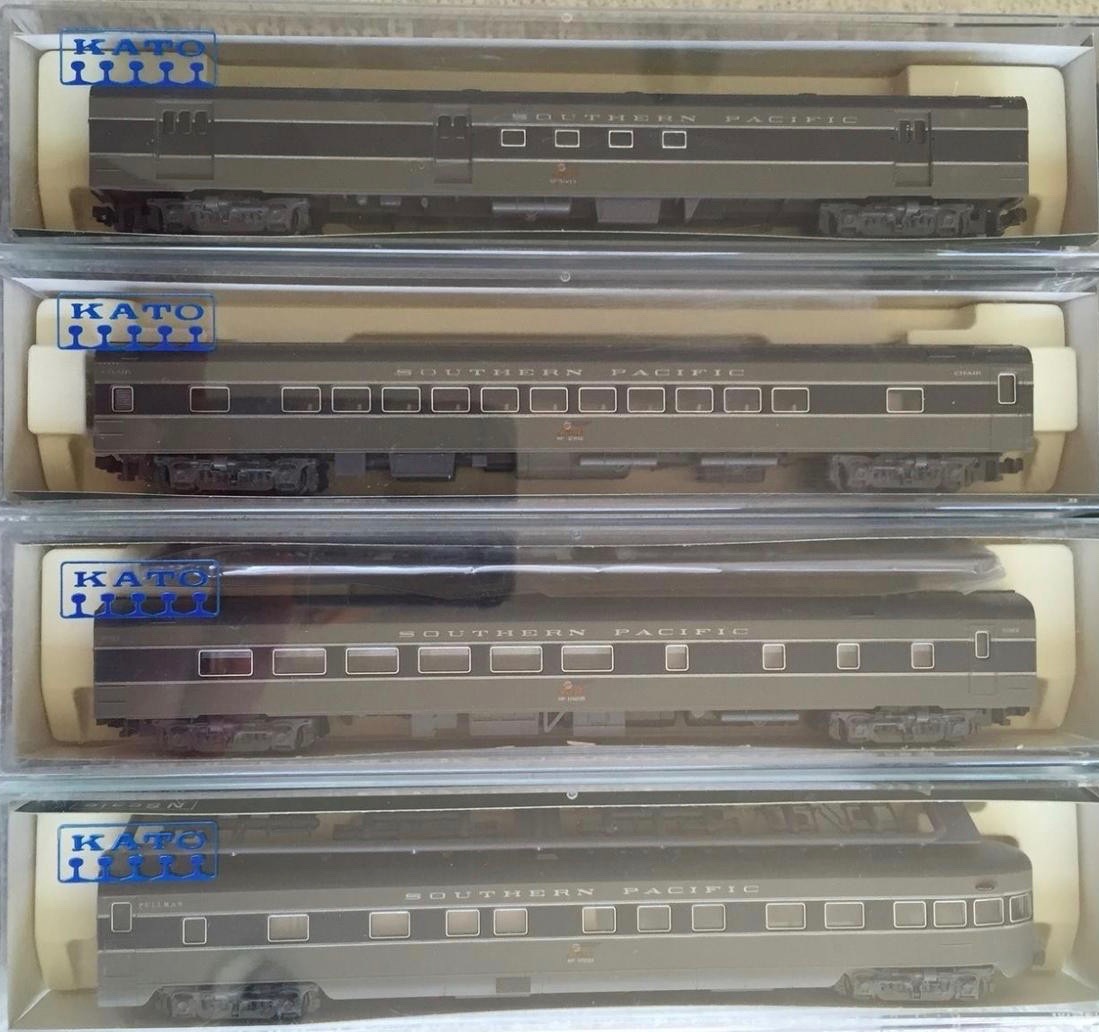Model Information: Life-Like first introduced this model in 2002 and did a rebuild in 2008. This is an attractive model with excellent detail. The first release lacks a traction tire and is not a particularly good puller. Furthermore although the tender has electrical pickup, the current is only used for the backup light and does not transfer to the motor in the locomotive.
The later release fortunately addresses all three issues. It has factory DCC with sound, has a traction tires and transfers current between the locomotive and the tender.
The later release fortunately addresses all three issues. It has factory DCC with sound, has a traction tires and transfers current between the locomotive and the tender.
DCC Information: The first release was DC only and the re-release in 2008 is available in DCC-Ready versions and DCC-with-sound. versions.
Prototype History: The USRA 2-8-8-2 was a USRA standard class of steam locomotive designed under the control of the United States Railroad Administration, the nationalized railroad system in the United States during World War I. These locomotives were of 2-8-8-2 wheel arrangement in the Whyte notation, or (1'D)'D1' in UIC classification. A total of 106 locomotives were built to this plan for the USRA; postwar, it became a de facto standard design.
While the 2-8-8-2 had been built in the United States since 1909, most development work had gone into making subsequent locomotives larger and heavier. The Norfolk and Western Railway however, had taken development in a different direction. By using smaller cylinders and higher boiler pressure, the result was a locomotive capable of powerful performance, and a turn of speed higher than the 20 mph (32 km/h) maximum of the ‘traditional’ designs. The USRA 2-8-8-2 drew heavily on the Norfolk and Western Railway’s Y-2 class locomotive design, as their delegate to the 2-8-8-2 design committee had brought a full set of blueprints.
From Wikipedia
While the 2-8-8-2 had been built in the United States since 1909, most development work had gone into making subsequent locomotives larger and heavier. The Norfolk and Western Railway however, had taken development in a different direction. By using smaller cylinders and higher boiler pressure, the result was a locomotive capable of powerful performance, and a turn of speed higher than the 20 mph (32 km/h) maximum of the ‘traditional’ designs. The USRA 2-8-8-2 drew heavily on the Norfolk and Western Railway’s Y-2 class locomotive design, as their delegate to the 2-8-8-2 design committee had brought a full set of blueprints.
From Wikipedia
Road Name History: The Atchison, Topeka and Santa Fe Railway (reporting mark ATSF), often abbreviated as Santa Fe or AT&SF, was one of the larger railroads in the United States. Chartered in February 1859, the railroad reached the Kansas-Colorado border in 1873 and Pueblo, Colorado, in 1876. To create a demand for its services, the railroad set up real estate offices and sold farm land from the land grants that it was awarded by Congress. Despite the name, its main line never served Santa Fe, New Mexico, as the terrain was too difficult; the town ultimately was reached by a branch line from Lamy.
The Santa Fe was a pioneer in intermodal freight transport, an enterprise that (at one time or another) included a tugboat fleet and an airline (the short-lived Santa Fe Skyway). Its bus line extended passenger transportation to areas not accessible by rail, and ferryboats on the San Francisco Bay allowed travelers to complete their westward journeys to the Pacific Ocean. The ATSF was the subject of a popular song, Harry Warren & Johnny Mercer's "On the Atchison, Topeka and the Santa Fe", written for the film, The Harvey Girls (1946).
The railroad officially ceased operations on December 31, 1996, when it merged with the Burlington Northern Railroad to form the Burlington Northern & Santa Fe Railway.
Read more on Wikipedia.
The Santa Fe was a pioneer in intermodal freight transport, an enterprise that (at one time or another) included a tugboat fleet and an airline (the short-lived Santa Fe Skyway). Its bus line extended passenger transportation to areas not accessible by rail, and ferryboats on the San Francisco Bay allowed travelers to complete their westward journeys to the Pacific Ocean. The ATSF was the subject of a popular song, Harry Warren & Johnny Mercer's "On the Atchison, Topeka and the Santa Fe", written for the film, The Harvey Girls (1946).
The railroad officially ceased operations on December 31, 1996, when it merged with the Burlington Northern Railroad to form the Burlington Northern & Santa Fe Railway.
Read more on Wikipedia.
Brand/Importer Information:  Life-Like Products LLC (now Life-Like Toy and Hobby division of Wm. K. Walthers) was a manufacturer of model railroad products and was based in Baltimore, Maryland.
Life-Like Products LLC (now Life-Like Toy and Hobby division of Wm. K. Walthers) was a manufacturer of model railroad products and was based in Baltimore, Maryland.
It was founded in the 1950s by a company that pioneered extruded foam ice chests under the Lifoam trademark. Because ice chests are a summer seasonal item, the company needed a way to keep the factory operating year round. As model railroading was becoming popular in the post-war years, they saw this as an opportunity and so manufactured extruded foam tunnels for model trains. Over the years, Life-Like expanded into other scenery items, finally manufacturing rolling stock beginning in the late 1960s. At some point in the early 1970s, Life-Like purchased Varney Inc. and began to produce the former Varney line as its own.
The Canadian distributor for Life-Like products, Canadian Hobbycraft, saw a missing segment in market for Canadian model prototypes, and started producing a few Canadian models that were later, with a few modifications, offered in the US market with US roadnames.
In 2005, the company, now known as Lifoam Industries, LLC, decided to concentrate on their core products of extruded foam and sold their model railroad operations to Wm. K. Walthers.
In June 2018, Atlas and Walthers announced to have reached an agreement under which all Walthers N scale rolling stock tooling, including the former Life-Like tooling, will be purchased by Atlas.
Read more on Wikipedia and The Train Collectors Association.

It was founded in the 1950s by a company that pioneered extruded foam ice chests under the Lifoam trademark. Because ice chests are a summer seasonal item, the company needed a way to keep the factory operating year round. As model railroading was becoming popular in the post-war years, they saw this as an opportunity and so manufactured extruded foam tunnels for model trains. Over the years, Life-Like expanded into other scenery items, finally manufacturing rolling stock beginning in the late 1960s. At some point in the early 1970s, Life-Like purchased Varney Inc. and began to produce the former Varney line as its own.
The Canadian distributor for Life-Like products, Canadian Hobbycraft, saw a missing segment in market for Canadian model prototypes, and started producing a few Canadian models that were later, with a few modifications, offered in the US market with US roadnames.
In 2005, the company, now known as Lifoam Industries, LLC, decided to concentrate on their core products of extruded foam and sold their model railroad operations to Wm. K. Walthers.
In June 2018, Atlas and Walthers announced to have reached an agreement under which all Walthers N scale rolling stock tooling, including the former Life-Like tooling, will be purchased by Atlas.
Read more on Wikipedia and The Train Collectors Association.
Item created by: gdm on 2018-05-24 14:23:17. Last edited by gdm on 2018-05-24 14:53:19
If you see errors or missing data in this entry, please feel free to log in and edit it. Anyone with a Gmail account can log in instantly.
If you see errors or missing data in this entry, please feel free to log in and edit it. Anyone with a Gmail account can log in instantly.











